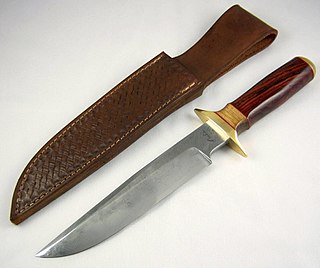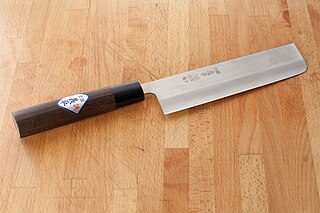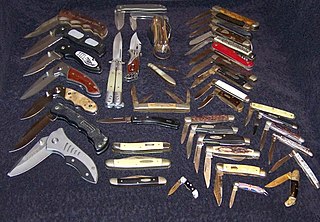
A utility knife is any type of knife used for general manual work purposes. Such knives were originally fixed-blade knives with durable cutting edges suitable for rough work such as cutting cordage, cutting/scraping hides, butchering animals, cleaning fish scales, reshaping timber, and other tasks. Craft knives are small utility knives used as precision-oriented tools for finer, more delicate tasks such as carving and papercutting.

A knife is a tool or weapon with a cutting edge or blade, usually attached to a handle or hilt. One of the earliest tools used by humanity, knives appeared at least 2.5 million years ago, as evidenced by the Oldowan tools. Originally made of wood, bone, and stone, over the centuries, in step with improvements in both metallurgy and manufacturing, knife blades have been made from copper, bronze, iron, steel, ceramic, and titanium. Most modern knives have either fixed or folding blades; blade patterns and styles vary by maker and country of origin.

A Japanese kitchen knife is a type of kitchen knife used for food preparation. These knives come in many different varieties and are often made using traditional Japanese blacksmithing techniques. They can be made from stainless steel, or hagane, which is the same kind of steel used to make Japanese swords. Most knives are referred to as hōchō or the variation -bōchō in compound words but can have other names including -kiri. There are four general categories used to distinguish the Japanese knife designs: handle, blade grind, steel, and construction.

Nakiri bōchō and usuba bōchō are Japanese-style vegetable knives. They differ from the deba bōchō in their shape, as they have a straight blade edge suitable for cutting all the way to the cutting board without the need for a horizontal pull or push. These knives are also much thinner. While the deba bōchō is a heavy blade for easy cutting through thin bones, the blade is not suitable for chopping vegetables, as the thicker blade can break the vegetable slice. The nakiri bōchō and the usuba bōchō have a much thinner blade. This does not help with cutting small bones in fish or meat, but is useful for cutting vegetables.

Usuba bōchō is the traditional vegetable knife for the professional Japanese chef. Like other Japanese professional knives, usuba are chisel ground, and have a bevel on the front side, and have a hollow ground urasuki on the back side. Usuba characteristically have a flat edge, with little or no curve, and are tall, to allow knuckle clearance when chopping on a cutting board. Usuba literally means "thin blade" indicating its relative thinness compared to other knives, required for cutting through firm vegetables without cracking them. Due to its height and straight edge, usuba are also used for specialized cuts such as katsuramuki, shaving a vegetable cylinder into a thin sheet.

A blade's grind is its cross-sectional shape in a plane normal to the edge. Grind differs from blade profile, which is the blade's cross-sectional shape in the plane containing the blade's edge and the centre contour of the blade's back. The grind of a blade should not be confused with the bevel forming the sharpened edge; it more usually describes the overall cross-section of the blade, not inclusive of the beveled cutting edge which is typically of a different, less acute angle as the bevel ground onto the blade to give it a cross-sectional shape. For example, the famous Buck 110 hunting knife has a "hollow ground" blade, with concave blade faces, but the cutting edge itself is a simple, flat-ground bevel of lesser angle. It would be difficult, if not impossible, to put a "hollow grind" onto the actual cutting edge of the blade itself, which is a very narrow and small bevel.

A pocketknife is a knife with one or more blades that fold into the handle. They are also known as jackknives (jack-knife), folding knives, EDC knife, or may be referred to as a penknife, though a penknife may also be a specific kind of pocketknife. A typical blade length is 5 to 15 centimetres.
A gravity knife is a knife with a blade contained in its handle, and that opens its blade through the force of gravity. This mechanism of opening is fundamentally different from the switchblade, which extends its spring-propelled blade automatically upon the push of a button, switch, or fulcrum lever. The main purpose of gravity opening is that it allows opening and closing to be done one handed, in situations where the other hand is occupied. Hence, historically they have been issued to parachutists to cut off caught lines, such as lines tangled in trees, a major potential use of the gravity knife.

A kitchen knife is any knife that is intended to be used in food preparation. While much of this work can be accomplished with a few general-purpose knives – notably a large chef's knife, a tough cleaver, a small paring knife and some sort of serrated blade – there are also many specialized knives that are designed for specific tasks. Kitchen knives can be made from several different materials.

The Santoku bōchō or Bunka bōchō (文化包丁) is a general-purpose kitchen knife originating in Japan. Its blade is typically between 13 and 20 cm long, and has a flat edge and a sheepsfoot blade that curves down an angle approaching 60 degrees at the point. The term Santoku may refer to the wide variety of ingredients that the knife can handle: meat, fish and vegetables, or to the tasks it can perform: slicing, chopping and dicing, either interpretation indicating a multi-use, general-purpose kitchen knife. The Santoku's blade and handle are designed to work in harmony by matching the blade's width and weight to the weight of the tang and the handle.
A boning knife is a type of kitchen knife with a sharp point and a narrow blade. It is used in food preparation for removing the bones of poultry, meat, and fish. Generally, 12 cm to 17 cm in length, it features a very narrow blade. Boning knives are not as thick-bladed as some of other popular kitchen or butcher knives, as this makes precision boning, especially deep cuts and holes easier. A stiff boning knife is good for boning beef and pork, but a very flexible boning knife is preferred for poultry and fish.

Survival knives are knives intended for survival purposes in a wilderness environment, often in an emergency when the user has lost most of their main equipment. Most military aviation units issue some kind of survival knife to their pilots in case their aircraft are shot down behind enemy lines and the crew needs tools to facilitate their survival, escape, and rescue. Survival knives can be used for trapping, skinning, wood cutting, wood carving, and other uses. Hunters, hikers, and outdoor sport enthusiasts use survival knives. Some survival knives are heavy-bladed and thick. Other survival knives are lightweight or fold in order to save weight and bulk as part of a larger survival kit. Their functions often include serving as a hunting knife. Features, such as hollow handles, that could be used as storage space for matches or similar small items, began gaining popularity in the 1980s. Custom or semi-custom makers such as Americans Gil Hibben, Jimmy Lile, Bo Randall, and Chris Reeve are often credited with inventing those features.

A cleaver is a large knife that varies in its shape but usually resembles a rectangular-bladed hatchet. It is largely used as a kitchen or butcher knife and is mostly intended for splitting up large pieces of soft bones and slashing through thick pieces of meat. The knife's broad side can also be used for crushing in food preparation and can also be used to scoop up chopped items.

A hunting knife is a knife used during hunting for preparing the game to be used as food: skinning the animal and cutting up the meat. It is different from the hunting dagger which was traditionally used to kill wild game.
A knife fight is a violent physical confrontation between two or more combatants in which one or more participants are armed with a knife. A knife fight is defined by the presence of a knife as a weapon and the violent intent of the combatants to kill or incapacitate each other; the participants may be completely untrained, self-taught, or trained in one or more formal or informal systems of knife fighting. Knife fights may involve the use of any type of knife, though certain knives, termed fighting knives, are purposely designed for such confrontations – the dagger being just one example.

Grafting or graftage is a horticultural technique whereby tissues of plants are joined so as to continue their growth together. The upper part of the combined plant is called the scion while the lower part is called the rootstock. The success of this joining requires that the vascular tissues grow together. The natural equivalent of this process is inosculation. The technique is most commonly used in asexual propagation of commercially grown plants for the horticultural and agricultural trades. The scion is typically joined to the rootstock at the soil line; however, top work grafting may occur far above this line, leaving an understock consisting of the lower part of the trunk and the root system.
Chris Reeve Knives is an American knife manufacturing corporation with international sales and distribution headquartered in Boise, Idaho, that designs, develops, and sells folding pocket knives and fixed-blade knives. Its products include the Sebenza, Inkosi, Umnumzaan, TiLock, Mnandi folding knives, Impinda slip joint, and the Green Beret, Pacific, Professional Soldier, Nyala, and Sikayo fixed blade knives. Chris Reeve Knives' industry contributions include the Integral Lock, contributions to the blade steels CPM-S30V and CPM-S35VN, and has won Blade Magazine's Blade Show Manufacturing Quality Award 15 times. Their motto is Think Twice, Cut Once.

A fillet knife is a kitchen knife used for filleting. It gives good control and aids in filleting. It is a very flexible member of the boning knife family that is used to filet and prepare fish. Fillet knife blades are typically 15 to 28 cm long. This allows them to move easily along the backbone and under the skin of meat.

An edged weapon, or bladed weapon, is a melee weapon with a cutting edge. Bladed weapons include swords, daggers, knives, and bayonets. Edged weapons are used to cut, hack, or slash; some edged weapons may also permit thrusting and stabbing. Edged weapons contrast with blunt weapons such as maces, and with thrusting weapons such as spears.
A Parmesan knife or grana knife is a knife with a drop-shaped blade and a round wooden handle used to break hard cheeses such as grana or Parmesan into shards. Bigger knives with a flat handle that can be hammered are used to cut open the cheese wheels, the crusts of which are rather hard.















